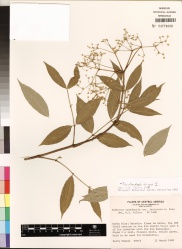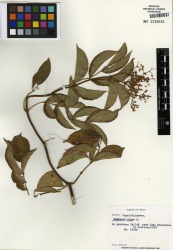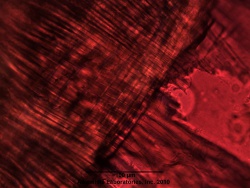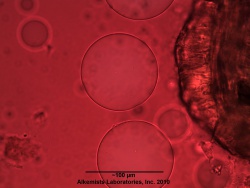Sambucus nigra (fruit)
(add USD 1918 information (organoleptic and macroscopic)) |
(add macro characteristics) |
||
| Line 40: | Line 40: | ||
{| border=1 | {| border=1 | ||
| | | | ||
| + | {{Macroscopy | source=American Medicinal Plants of Commercial Importance (1930) | ||
| + | | description=[American] Elder [''Sambucus canadensis''] is a shrub attaining a height of 6 to 10 feet, its light gray, numerous stems being generally smooth and the younger ones containing a large white pith. The leaves are large and consist of 5 to 11 leaflets about 2 to 5 inches in length borne on short stalks. About June or July the flat-topped, fragrant clusters appear, composed of numerous, 5-lobed, wheel-shaped, creamy-white flowers. The clusters of edible fruits which follow are black or a very dark purple, small, round, shining, and juicy. | ||
| + | }} | ||
| + | |||
{{Macroscopy | source=United States Dispensatory (1918) | {{Macroscopy | source=United States Dispensatory (1918) | ||
| description=''Sambucus canadensis'', [American elder,] is a shrub from six to ten feet high, with a branching stem, covered with a rough gray bark, and containing a large spongy pith. The small branches and leaf-stalks are very smooth. The leaves are opposite, pinnate, sometimes bipinnate, and composed usually of five to nine oblong-oval, acuminate, smooth, shining, deep-green leaflets; the veins of the under surface are somewhat pubescent. The flowers are small, white, and disposed in loose cymes; the cream-colored corolla is wheel-shaped, with five stamens on the tube. The berries are small, globular, and deep purple when ripe. The shrubs grow in low, moist grounds, along fences, and on the borders of small streams, throughout the United States, from Canada to the Carolinas, and westward as far as Arizona and Texas. It flowers from May to July, and ripens its fruit early in autumn. | | description=''Sambucus canadensis'', [American elder,] is a shrub from six to ten feet high, with a branching stem, covered with a rough gray bark, and containing a large spongy pith. The small branches and leaf-stalks are very smooth. The leaves are opposite, pinnate, sometimes bipinnate, and composed usually of five to nine oblong-oval, acuminate, smooth, shining, deep-green leaflets; the veins of the under surface are somewhat pubescent. The flowers are small, white, and disposed in loose cymes; the cream-colored corolla is wheel-shaped, with five stamens on the tube. The berries are small, globular, and deep purple when ripe. The shrubs grow in low, moist grounds, along fences, and on the borders of small streams, throughout the United States, from Canada to the Carolinas, and westward as far as Arizona and Texas. It flowers from May to July, and ripens its fruit early in autumn. | ||
Latest revision as of 14:41, 24 June 2015
Contents |
Nomenclature
Sambucus nigra L. Caprifoliaceae
Standardized common name (English): European elder
Botanical Voucher Specimen
|
|
|
Organoleptic Characteristics
|
Macroscopic Characteristics
|
Microscopic Characteristics
 |
 |
|
|
|
High Performance Thin Layer Chromatographic Identification
Supplementary Information
Sources
- ↑ MOBOT, Tropicos.org http://www.tropicos.org/Image/71201
- ↑ MOBOT, Tropicos.org http://www.tropicos.org/Image/100000898
- ↑ United States Dispensatory (1918)
- ↑ American Medicinal Plants of Commercial Importance (1930)
- ↑ United States Dispensatory (1918)
- ↑ Elan M. Sudberg, Alkemist Laboratories http://www.alkemist.com
- ↑ Elan M. Sudberg, Alkemist Laboratories http://www.alkemist.com



